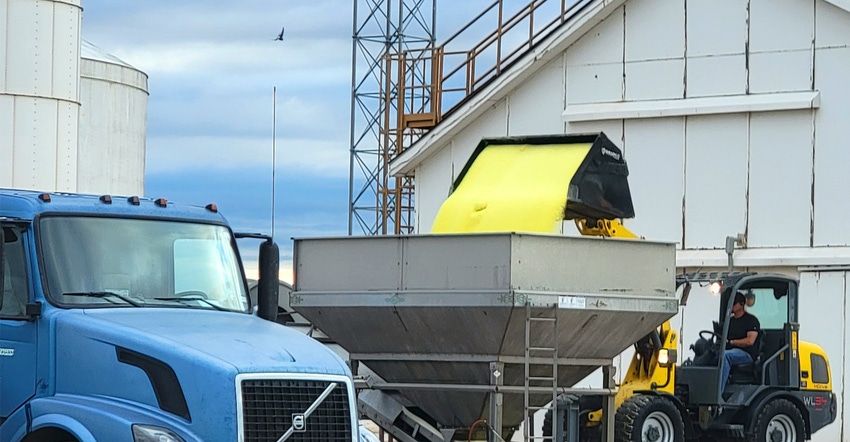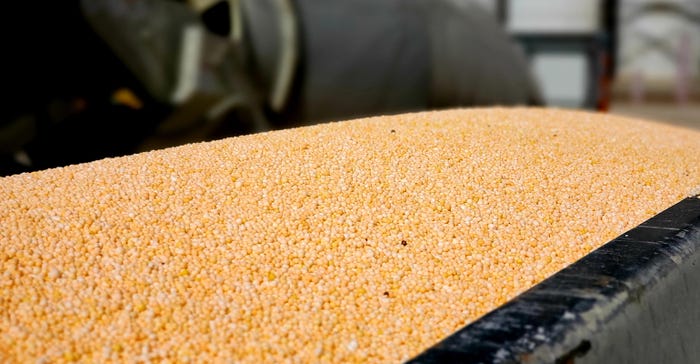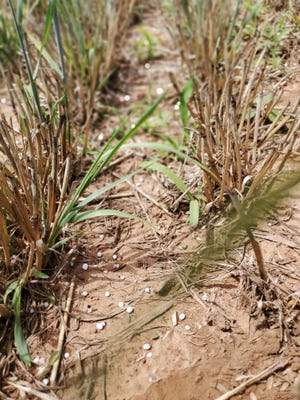
Before farmers finish harvesting 2021 crops, many are already voicing concern over 2022 budgets that show fertilizer, chemicals, and steel costs posting significant increases.
Even with continued good prices — $1cotton for instance — producers say maintaining a profit with higher production costs will not be easy. Those concerns are real, say Extension and key farm organization spokespersons.
Most anticipate continuing upward pressure on fertilizer and chemicals with shortages of some products also possible.
 Dry fertilizer. Fertilizer prices are expected to continue to rise, shortages possible for some products. (Photo by Shelley E. Huguley)
Dry fertilizer. Fertilizer prices are expected to continue to rise, shortages possible for some products. (Photo by Shelley E. Huguley)
National Cotton Council Vice President, Economics and Policy Analysis, Jody Campiche, says chemical and fertilizer prices have already increased significantly since this past spring. In the Southeast region, average prices for nitrogen increased from $250 per ton in April 2021 to $440 per ton last week [mid-October].
With higher inflation expected in 2022, we could see another increase in input prices before next planting season.”
Shortages
The supply chains that are critical for inputs and sales of goods face various challenges. This has led to higher prices for inputs, and in some cases, the inability to purchase goods or services regardless of price.
“We see a lot of reasons for the supply chain issues. Tariffs, trade wars, hurricanes that closed plants and delayed river transport, the COVID-19 pandemic, transportation, supply and cost of natural gas, and labor shortages all affect product availability and cost.”
She says container availability and cost adds to the problem. Freight charges from Asia to the U.S. have increased significantly in the last year.
General freight trucking costs are up by 21% from last summer, while rail costs are up by 28%. Costs are higher due to increased demand for the shipments of goods as well as higher fuel prices and a continued supply shortage of truck drivers.
“Although I don’t have data showing key product availability for 2022, as we look across agriculture, as well as other industries, we are likely to see higher input prices and lower availability. Some facilities shut down for COVID-19. Now, we have used up any excess inventory.”
Campiche says high steel costs add to equipment expense, and some industries can’t get parts for computers. “Some facilities are not producing items producers need.”
Profit margins shrinking
She said the current favorable cotton market — $1.07 for Dec. 2021, at the time of the interview — might appear to be a windfall for farmers. And it is a welcome change. “A lot of folks look at those high prices and assume farmers are making a lot of money. But factor in fertilizer and chemicals and profit margins shrink.”
Related: Getting insight on the upcoming supply challenges of 2022
She says fertilizer makes up about 12% of overall cotton production costs based on the USDA ERS cost of production data. Chemicals account for about 10%. “Along with large increases in fertilizer and chemical costs, everything else — seed, labor, fuel, and other inputs — could also be higher in 2022. Factor in those input costs and producers are not making much more money.”
Campiche also says dollar cotton typically doesn’t last long, but this is an unusual year. “Dec. 2022 cotton is just under 90 cents. Balance sheets with lower cotton prices and anticipated higher input costs are not quite as good.”
 Plowing in fertilizer. (Photo by Shelley E. Huguley)
Plowing in fertilizer. (Photo by Shelley E. Huguley)
She adds that good cotton prices could also lead to increased acreage next year, which also puts a strain on input availability. “If available, producers might consider securing some products they need for next season now,” she says.
Kody Bessent, chief executive officer, Plains Cotton Growers, Inc., Lubbock, agrees.
“Margins certainly could be thin for this next crop year if input costs remain high relative to cost of production,” Bessent says.
Purchase early
“As for chemicals and fertilizer, several companies and retailers are making efforts to encourage producers to make advance purchases of product so they can attempt to secure enough before getting into next year’s crop.
“Ongoing transportation issues, especially ocean freight, could limit product availability since some of the active ingredients needed to mix with the chemistry comes from overseas. Additionally, fertilizer prices are increasing significantly.”
So far, producers have been able to get parts, Bessent says, but with some exceptions.
“I have not heard of many incidents of parts shortages other than from a couple of producers mentioning they had been trying to locate tires, and when they did find the right size/set they were very expensive.
“Certainly, this will be an ongoing concern as more producers need readily available parts and products such as belts, bats and brushes and other parts necessary for repair or maintenance during harvest season and going into next year’s crop.”
He says machinery has been very difficult to come by. “I do not expect this to change very abruptly.”
Some producers are looking for 2022 contracts.
“With cotton prices trading where there are today, I have heard of some producers trying to find contracts for the 2022 crop year to take advantage of the pricing opportunity, but that has been very limited.
Harvest aid products seem to be in adequate supply, he says. “In the short term, harvest aids for cotton defoliation and boll opener have been readily available going into harvest season and the same holds for module wrap for round bales.”
Smart management
“I would advise farmers to be judicious with fertilizer purchases and applications. Soil sampling can save or make them money,” says Roger Sahs, associate Extension specialist, Oklahoma State University, Stillwater.
“Producers need to be more efficient when applying the fertilizer by working it into the soil or even applying the nutrient with a drill or air-seeder to limit the impact from water or wind.
“They should pencil out cropping plans through crop budgets, which can show where the smart dollars may be spent on fertilizer.”
He agrees that fertilizer prices will continue to rise.
 Fertilizer waiting to be plowed. Prices are expected to stay high. "China supplies about a third of the world's phosphate, and it has essentially banned exports through 2022. Supplies will stay tight for some time..." says Roger Sahs, associate Extension specialist, Oklahoma State University, Stillwater. (Photo by Shelley E. Huguley)
Fertilizer waiting to be plowed. Prices are expected to stay high. "China supplies about a third of the world's phosphate, and it has essentially banned exports through 2022. Supplies will stay tight for some time..." says Roger Sahs, associate Extension specialist, Oklahoma State University, Stillwater. (Photo by Shelley E. Huguley)
“I expect fertilizer prices to stay at these high levels and may continue rising into next spring. China supplies about a third of the world's phosphate, and it has essentially banned exports through 2022. Supplies will stay tight for some time as the U.S. probably won’t expand mines and phosphate production due to environment concerns.
“Production of nitrogen-based fertilizer depends a great deal on the price of natural gas,” Sahs adds. “And while the U.S. may be able to expand production, that doesn’t happen overnight and supply disruptions from a harsh, cold winter will put even more pressure on nitrogen prices.”
Expect backorders
“Farmers need to be aware that even little purchases may be met with backorders and long wait times,” says OSU Extension economist Trent Milacek. “Parts, equipment, chemical and other crop input availability can be two to three months out.
“We are still able to secure the items we need for the most part,” Milacek adds, “but planning becomes crucial. I encourage producers to take some off time in the winter and devote it to planning for the growing season. Try to secure crop chemicals ahead of time and have them sitting in your barn when spring rolls around.
“We can also pre-purchase filters and oil and other general maintenance items that are a yearly requirement.”
Big ticket items might include longer wait times. “If producers need to purchase equipment, they should try to order the quarter before they believe they will need it to ensure they have an opportunity to shop around and wait on lead times.”
He says these difficult times in agriculture “will favor the good managers who plan ahead and prepare for the coming crop year.”
Costs will increase, he adds. “Economically, everything will become more expensive to produce. We have seen nitrogen fertilizer increase by as much as three times year-ago levels.”
Marginal economics
Apply inputs wisely, he says. “It is important to remember marginal economics. Even at current prices, fertilizer will pay for itself if we get enough moisture to justify the application. Top-dress will be important in order to delay application to get a better idea of the growing conditions the crop will face.
“Markets have been rather generous over the past several months, and I encourage producers to get aggressive with forward contracting as they prepay for inputs in the coming year. Offset higher input prices by securing good crop prices through forward contracting or a hedge in the futures market.”
Risk mitigation
OSU Economics Assistant Professor Courtney Bir says producers should consider risk mitigation and strategic decision making. “Those are very producer/operator dependent,” she says. “The first step to mitigating risk is for producers to understand their own current financial position.”
OSU can help. “Right now, we are helping farmers and ranchers in Oklahoma understand their financial health by helping them complete beginning and ending balance sheets, as well as additional analyses.”
The program is free, she says. It also qualifies for FSA borrower training, if producers need that service too, but the cost is $150.”
She encourages producers and operators to check the OSU Extension farm financial planning website for more information.
“It’s a crazy time,” Campiche says. “We’re not through harvesting for 2021 yet and already thinking about securing ‘22 inputs.”
Farming smart has never been more important.
About the Author(s)
You May Also Like






